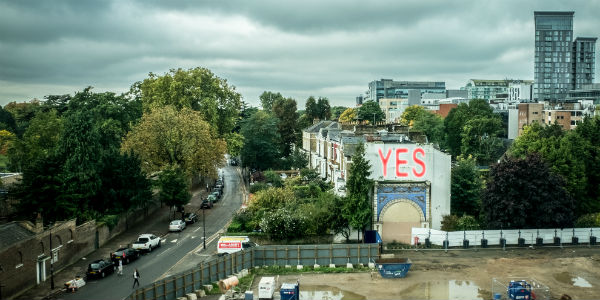Neighbourhood Forums: six years old, and less powerful than they thought they might be
Created by the Localism Act in 2011, Neighbourhood Development Plans were hailed as a way to give local people more say in planning issues. But some of the conflicts that have ensued between Neighbourhood Forums and local councils show how difficult it is to shift power downwards, writes John Sturzaker (University of Liverpool). Cases in Wycombe and Exeter have confirmed that local authorities can still trump the result of Forum referendums – which can attract few voters.

Pro-Yes campaigners for a Central Ealing Neighbourhood Forum displayed the word on local buildings in October 2017. The result was an overwhelming Yes vote on a 17% turnout. Photo: Roger via a CC-BY-SA 2.0 licence
Shifting power “downwards” or “outwards” from the central state is a common feature of many 21st-century democracies. Although somewhat late to the party, the UK government has begun to follow the trend of other countries, and the 2011 Localism Act was a key piece of legislation in the area. It introduced reforms to various fields of public policy, particularly land-use planning.
Various justifications were made for these reforms, which claimed to herald a shift in power from central government towards communities and individuals, but the most commonly used were variations on the concept of “deepening” democracy – that taking power away from the centre and transferring it to local people would enhance people’s participation in and engagement with society. This is a powerful and persuasive argument, but it conceals much tension and complexity.
The reforms to the planning system in England instituted by the 2011 Act are wide-ranging, including the abolition of the regional tier of planning (the Regional Spatial Strategies), leaving England more or less unique in Western Europe as lacking comprehensive strategic planning. The particular aspect of the 2011 Act which I focus on here is the introduction of a new, community tier of planning – Neighbourhood Development Plans (NDPs). These new plans are to be produced by, in rural areas, pre-existing town and parish councils. In urban areas they created new Neighbourhood Forums. The latter are intended to coalesce voluntarily around a spatially defined neighbourhood of their own devising; the former have long-established boundaries which vary significantly in scale, from perhaps less than 100 to more than 40,000.
When the Localism Bill was initially laid before Parliament in December 2010, the local government secretary at the time, Eric Pickles, claimed that through NDPs “communities with the vision and drive to build more homes will be given the freedom to achieve their ambitions”. Initially it appeared as if NDPs would allow local communities also to reject new housing if they lacked this “vision and drive”, leading to accusations that they were a “NIMBY’s charter”. The Government swiftly changed its mind on this issue, introducing a requirement that NDPs could not propose less housing than was included in existing plans produced by local authorities.
This is the first tension in the new system – from the outset, it was built into the system that decisions reached at the local authority scale regarding housing needs could outweigh those at the community scale. The system also privileges the local authority in several other ways – for instance, Daws Hill Neighbourhood Forum sought judicial review after Wycombe District Council amended their application for an NDP area (the first stage in NDP production). In refusing the application for judicial review of Wycombe’s decision, a decision subsequently affirmed in the Court of Appeal, the judge noted that local authorities were given a broad discretion to amend NDP areas in the regulations governing the process.
A case in Exeter St James – an early referendum success – illustrates that even after adoption of a neighbourhood plan, the local authority remains the arbiter of planning issues. In that case, the local authority approved a planning application for a housing development at Exeter Cricket Club that the Neighbourhood Forum felt contradicted their NDP. The case illustrates that NDP policies, as with local plan policies, are open to interpretation and are weighed in the balance with other issues. Exeter City Council decided other factors outweighed the apparent contradiction with the NDP. It also illustrates that in several ways the traditional representative democracy embodied by local authorities trumps the participatory democracy implicit in the production of NDPs – and indeed the direct democracy at their core, linking to the second tension.
NDPs are unique in the English planning system in that to be adopted they must be endorsed by the majority of the electorate in the neighbourhood through a simple yes/no referendum. There have so far been more than 400 referendums, the vast majority voting “yes”, but turnout has been variable. Analysis of the first 200 found average turnout of 32.4% – broadly in line with turnouts for local or European elections but not as high as early commentators hoped, casting into doubt some of the more hyperbolic claims of NDPs. Leaving aside the question of turnout, there are other issues with the representativeness of NDPs – in Thame, South Oxfordshire, a 76% majority voted “yes” in their referendum, but some expressed disquiet at the exclusionary nature of the NDP-making process.
A third tension is the role of the independent actors in the system, specifically the courts and the independent examiners whose role is to decide whether draft NDPs should go forward to referendums. The regulations governing the production of NDPs were designed to be “light touch” to make it easier for communities – and this included the independent examination which is a feature of most parts of the English planning system. For local plans this examination is undertaken by a professional Planning Inspector, appointed by the Planning Inspectorate, an agency of the Department for Communities and Local Government. However, for NDPs, the examiner need only be an independent expert. The extent to which an examiner is independent has been subject to judicial review in at least one case, and the ability of examiners to make binding recommendations for NDP alterations has been a source of complaint for more than one community. Meanwhile, notwithstanding the Daws Hill case referred to above, early evidence suggests that the courts have adopted a fairly relaxed approach to the legality of NDPs, and are seemingly reluctant to penalise communities for relatively minor technical problems – perhaps maintaining the “light touch” hoped for by the Government.
What these examples show is that high-flown rhetoric about the empowerment of citizens and dispersal of power from government does not always survive the legislation and its application to the messy realities of everyday life. Competing democratic mandates, each with its own claim to legitimacy, operate within the English planning system – and they combine to make the Government’s latest call for an increase in housebuilding as hard to deliver as ever.
This post represents the views of the author and not those of Democratic Audit. It is based on an article co-authored with Michael Gordon, Democratic tensions in decentralised planning – Rhetoric, legislation and reality in England in Environment and Planning C: Politics and Space.
 Dr John Sturzaker is a Senior Lecturer in Civic Design/Planning at the School of Environmental Sciences, University of Liverpool. Twitter @johnsturzaker
Dr John Sturzaker is a Senior Lecturer in Civic Design/Planning at the School of Environmental Sciences, University of Liverpool. Twitter @johnsturzaker





 Democratic Audit's core funding is provided by the Joseph Rowntree Charitable Trust. Additional funding is provided by the London School of Economics.
Democratic Audit's core funding is provided by the Joseph Rowntree Charitable Trust. Additional funding is provided by the London School of Economics.
[…] researcher John Sturzaker has just had a blog on neighbourhood planning published at http://www.democraticaudit.com, based on this paper he co-authored […]